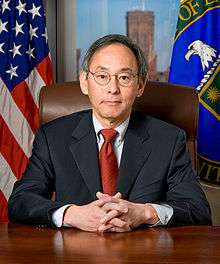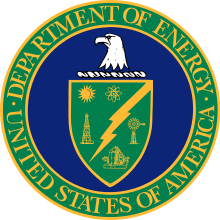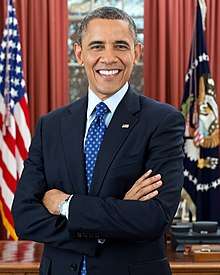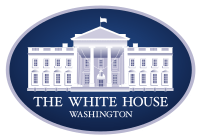Steven Chu
Steven Chu[3] (born February 28, 1948)[4] is an American physicist, Nobel laureate, and the 12th United States Secretary of Energy. He is currently the William R. Kenan, Jr., Professor of Physics and Professor of Molecular and Cellular Physiology at Stanford University. He is known for his research at the University of California at Berkeley and his research at Bell Laboratories and Stanford University regarding the cooling and trapping of atoms with laser light, for which he shared the 1997 Nobel Prize in Physics with Claude Cohen-Tannoudji and William Daniel Phillips.[5]
Steven Chu | |
|---|---|
 | |
| 12th United States Secretary of Energy | |
| In office January 21, 2009 – April 22, 2013 | |
| President | Barack Obama |
| Deputy | Daniel Poneman |
| Preceded by | Samuel Bodman |
| Succeeded by | Ernest Moniz |
| Personal details | |
| Born | February 28, 1948 St. Louis, Missouri, U.S. |
| Political party | Democratic[1][2] |
| Spouse(s) | Lisa Chu-Thielbar (divorced) Jean Fetter ( m. 1997) |
| Children | 2 |
| Father | Ju-Chin Chu |
| Relatives |
|
| Education | University of Rochester (BA, BS) University of California, Berkeley (MS, PhD) |
| Awards | Nobel Prize in Physics (1997) |
| Website | University website |
| Scientific career | |
| Fields | Atomic physics, biological physics, polymer physics |
| Institutions | |
| Thesis | Observation of the forbidden magnetic dipole transition 6²P1/2-7²P1/2 in atomic thallium (1976) |
| Doctoral advisor | Eugene D. Commins |
| Doctoral students | Michale Fee |
| Chinese name | |
| Chinese | 朱棣文 |
| Hanyu Pinyin | Zhū Dìwén |
Chu served as United States Secretary of Energy under the administration of President Barack Obama from 2009 to 2013. At the time of his appointment as Energy Secretary, Chu was a professor of physics and molecular and cellular biology at the University of California, Berkeley, and the director of the Lawrence Berkeley National Laboratory, where his research[6][7][8] was concerned primarily with the study of biological systems at the single molecule level.[9] Chu resigned as energy secretary on April 22, 2013.[10][11][12][13][14] He returned to Stanford as Professor of Physics and Professor of Molecular & Cellular Physiology.
Chu is a vocal advocate for more research into renewable energy and nuclear power, arguing that a shift away from fossil fuels is essential to combating climate change.[15][16][17] He has conceived of a global "glucose economy", a form of a low-carbon economy, in which glucose from tropical plants is shipped around like oil is today.[18] On February 22, 2019, Chu began a one-year term as president of the American Association for the Advancement of Science.[19]
Early life and education
Chu was born in St. Louis, Missouri,[20] with Chinese ancestry from Liuhe, Taicang, Jiangsu province,[21] and graduated from Garden City High School.[22] He received both a B.A. in mathematics and a B.S. in physics in 1970 from the University of Rochester.[23] He went on to earn his Ph.D. in physics from the University of California, Berkeley under Eugene D. Commins, in 1976,[24] during which he was supported by a National Science Foundation Graduate Research Fellowship.[25]
Chu comes from a family of highly educated white collar professionals and scholars. His father, Ju-Chin Chu, earned a doctorate in chemical engineering from MIT and taught at Washington University in St. Louis and Brooklyn Polytechnic Institute, and his mother studied economics at MIT. His maternal grandfather, Shu-tian Li, was a hydraulic engineer who earned a Ph.D. from Cornell University, and was a professor and president of Tianjin University (Peiyang University). His mother's uncle, Li Shu-hua, a biophysicist, studied physics at the University of Paris before returning to China.[5] Chu's older brother, Gilbert Chu, is a professor of biochemistry and medicine at Stanford University. His younger brother, Morgan Chu, is a patent lawyer who is the former co-managing partner at the law firm Irell & Manella.[26] According to Chu, his two brothers and four cousins have four Ph.D.s, three M.D.s, and a J.D. among them.
Career and research

After obtaining his doctorate he remained at Berkeley as a postdoctoral researcher for two years before joining Bell Labs, where he and his several co-workers carried out his Nobel Prize-winning laser cooling work. He left Bell Labs and became a professor of physics at Stanford University in 1987,[5] serving as the chair of its Physics Department from 1990 to 1993 and from 1999 to 2001. At Stanford, Chu and three others initiated the Bio-X program, which focuses on interdisciplinary research in biology and medicine,[27] and played a key role in securing the funding for the Kavli Institute for Particle Astrophysics and Cosmology.[28] In August 2004, Chu was appointed as the director of the Lawrence Berkeley National Laboratory, a U.S. Department of Energy National Laboratory, and joined UC Berkeley's Department of Physics and Department of Molecular and Cell Biology.[29] Under Chu's leadership, the Lawrence Berkeley National Laboratory was a center of research into biofuels and solar energy.[15] He spearheaded the laboratory's Helios project, an initiative to develop methods of harnessing solar power as a source of renewable energy for transportation.[29]
Chu's early research focused on atomic physics by developing laser cooling techniques and the magneto-optical trapping of atoms using lasers. He and his co-workers at Bell Labs developed a way to cool atoms by employing six laser beams opposed in pairs and arranged in three directions at right angles to each other. Trapping atoms with this method allows scientists to study individual atoms with great accuracy. Additionally, the technique can be used to construct an atomic clock with great precision.[30]
At Stanford, Chu's research interests expanded into biological physics and polymer physics at the single-molecule level. He studied enzyme activity and protein and RNA folding using techniques like fluorescence resonance energy transfer, atomic force microscopy, and optical tweezers. His polymer physics research used individual DNA molecules to study polymer dynamics and their phase transitions. He continued researching atomic physics as well and developed new methods of laser cooling and trapping.[31]
Honors and awards

Steven Chu is a co-winner of the Nobel Prize in Physics in 1997 for the "development of methods to cool and trap atoms with laser light", shared with Claude Cohen-Tannoudji and William Daniel Phillips.[32]
He is a member of the U.S. National Academy of Sciences, the American Academy of Arts and Sciences, the American Philosophical Society, the Pontifical Academy of Sciences and the Academia Sinica of Taiwan, and is a foreign member of the Chinese Academy of Sciences and the Korean Academy of Science and Engineering.[33] He was also awarded the Humboldt Prize by the Alexander von Humboldt Foundation in 1995. In 1998, Chu received the Golden Plate Award of the American Academy of Achievement.[34]

Chu received an honorary doctorate from Boston University when he was the keynote speaker at the 2007 commencement exercises.[35] He is a Senior Fellow of the Design Futures Council.[36] Diablo Magazine awarded him an Eco Award in its April 2009 issue,[37] shortly after he was nominated for Energy Secretary.
Washington University in St. Louis and Harvard University awarded him honorary doctorates during their 2010 and 2009 commencement exercises, respectively.[38][39] He was awarded an honorary degree from Yale University during its 2010 commencement.[40] He was also awarded an honorary degree from the Polytechnic Institute of New York University, the same institution at which his father taught for several years, during its 2011 commencement.[41] Penn State University awarded him an honorary doctorate during their 2012 commencement exercises.[42] In 2014, Chu was awarded an honorary doctorate from Williams College, during which he gave a talk moderated by Williams College Professor Protik Majumder.[43] Chu was also awarded an honorary doctorate from Amherst College in 2017, where he later gave a lecture titled "Climate Change and Needed Technical Solutions for a Sustainable Future" in March 2018.[44][45]
Chu was elected an international fellow of the Royal Academy of Engineering UK in 2011, and a Foreign Member of the Royal Society (ForMemRS) in 2014.[46] His nomination reads:
Steven Chu's development of methods to laser cool and trap atoms was recognised by the award of the Nobel Prize in Physics in 1997. He also pioneered the development of atom interferometry for precision measurement, and he introduced methods to visualize and manipulate single bio-molecules simultaneously with optical tweezers. Throughout his career, he has sought new solutions to the energy and climate challenges. From January 2009 to April 2013, he was the 12th U.S. Secretary of Energy under President Barack Obama, and initiated the Advanced Research Projects Agency - Energy, the Energy Innovation Hubs, and the Clean Energy Ministerial meetings.[47]
U.S. Secretary of Energy

.jpg)
His nomination to be Secretary of Energy was unanimously confirmed by the U.S. Senate on January 20, 2009.[48] On January 21, 2009, Chu was sworn in as Secretary of Energy in the Barack Obama administration. Chu is the first person appointed to the U.S. Cabinet after having won a Nobel Prize.[49] He is also the second Chinese American to be a member of the U.S. Cabinet, after former Secretary of Labor Elaine Chao.[50]
His scientific work continued, however, and he even published a paper on gravitational redshift in Nature in February 2010[51] and another one he co-authored in July 2010.[52][53]
In March 2011 Chu said that regulators at the U.S. Nuclear Regulatory Commission should not delay approving construction licenses for planned U.S. nuclear power plants in the wake of the Fukushima Daiichi nuclear disaster in Japan.[54]
In August 2011 Chu praised an advisory panel report on curbing the environmental risks of natural-gas development. Chu responded to the panel's report on hydraulic fracturing, the controversial drilling method that is enabling a U.S. gas boom while bringing fears of groundwater contamination. The report called for better data collection of air and water data, as well as "rigorous" air pollution standards and mandatory disclosure of the chemicals used in the hydraulic fracturing process. Chu said that he would "be working closely with my colleagues in the Administration to review the recommendations and to chart a path for continued development of this vital energy resource in a safe manner".[55]
Chu faced controversy for a statement he made prior to being appointed, claiming in a September 2008 interview with the Wall Street Journal that "somehow we have to figure out how to boost the price of gasoline to the levels in Europe."[56] However, in March 2012 he retracted this comment, saying "since I walked in the door as secretary of Energy I've been doing everything in my powers to do what we can to … reduce those prices" and that he "no longer shares the view [that we need to figure out how to boost gasoline prices in America]".[57]
On February 12, 2013, Chu was the designated survivor during the State of the Union address.[58]
On February 1, 2013, Chu announced his intent to resign.[12][59] In his resignation announcement, he warned of the risks of climate change from continued reliance on fossil fuels, and wrote, "the Stone Age did not end because we ran out of stones; we transitioned to better solutions".[60] He resigned on April 22, 2013.
Energy and climate change
Chu has been a vocal advocate for more research into renewable energy and nuclear power, arguing that a shift away from fossil fuels is essential to combat climate change and global warming.[15][16][17] He also spoke at the 2009 and 2011 National Science Bowl about the importance of America's science students, emphasizing their future role in environmental planning and global initiative. Chu said that a typical coal power plant emits 100 times more radiation than a nuclear power plant.[61]

Chu warns that global warming could wipe out California farms within the century.[62]
He joined the Copenhagen Climate Council, an international collaboration between business and science established to create momentum for the 2009 UN Climate Change Conference in Copenhagen, Denmark.[63]
In 2015, Chu signed the Mainau Declaration 2015 on Climate Change on the final day of the 65th Lindau Nobel Laureate Meeting. The declaration was signed by a total of 76 Nobel Laureates and handed to then-President of the French Republic, François Hollande, as part of the successful COP21 climate summit in Paris.[64]
Chu was instrumental in submitting a winning bid for the Energy Biosciences Institute, a BP-funded $500 million multidisciplinary collaboration between UC Berkeley, the Lawrence Berkeley Lab, and the University of Illinois. This sparked controversy on the Berkeley campus, where some fear the alliance could harm the school's reputation for academic integrity.[65][66][67][68]
Based partially on his research at UC Berkeley, Chu has speculated that a global "glucose economy", a form of a low-carbon economy, could replace the current system. In the future, special varieties of high-glucose plants would be grown in the tropics, processed, and then the chemical would be shipped around like oil is today to other countries. The St. Petersburg Times has stated that Chu's concept "shows vision on the scale needed to deal with global warming".[18]
Chu has also advocated making the roofs of buildings and the tops of roads around the world white or other light colors, which may reflect sunlight back into space and mitigate global warming. The effect would be, according to Chu, similar to taking every car in the world off the roads for about 11 years.[18] Samuel Thernstrom, a resident fellow at the American Enterprise Institute and co-director of its Geoengineering Project, expressed support for the idea in The American, praising Chu for "do[ing] the nation a service" with the concept.[69] Chu is on the board of directors of Xyleco, a company developing alternate energy.[70]
Personal life
In 1997, he married Jean Fetter, a British-American Oxford-trained physicist.[20] He has two sons, Geoffrey and Michael, from a previous marriage to Lisa Chu-Thielbar.[5]
Chu is interested in sports such as baseball, swimming, and cycling. He taught himself tennis—by reading a book—in the eighth grade, and was a second-string substitute for the school team for three years. He also taught himself how to pole vault using bamboo poles obtained from the local carpet store.[5] Chu said he never learned to speak Chinese because his parents always spoke to their children in English.[20]
See also
References
- Steven Chu's file. PolitiFact. Retrieved on 2012-02-04.
- "Fundraising activities are limited, but star power brings in the bucks". Archived from the original on 2012-02-15. Retrieved 2012-02-15.
- Chu, Steven was elected a fellow of the American Physical Society in 1986 for his contributions in atomic physics and laser spectroscopy, including the first observation of parity non-conservation in atoms, excitation and precision spectroscopy of positronium, and the optical confinement and cooling of atoms.
- O'Shea, Jennifer L. (December 30, 2008). "10 Things You Didn't Know About Steven Chu; Steven Chu is President-elect Obama's pick for energy secretary". U.S. News & World Report. Retrieved December 17, 2012.
- Frängsmyr, Tore, ed. (1998). "Steven Chu Autobiography". The Nobel Prizes 1997. Les Prix Nobel. Stockholm: The Nobel Foundation. Retrieved 2007-06-25.
- Ashkin, A.; Dziedzic, J. M.; Bjorkholm, J. E.; Chu, S. (1986). "Observation of a single-beam gradient force optical trap for dielectric particles". Optics Letters. 11 (5): 288. Bibcode:1986OptL...11..288A. CiteSeerX 10.1.1.205.4729. doi:10.1364/OL.11.000288. PMID 19730608.
- Raab, E.; Prentiss, M.; Cable, A.; Chu, S.; Pritchard, D. (1987). "Trapping of Neutral Sodium Atoms with Radiation Pressure". Physical Review Letters. 59 (23): 2631–2634. Bibcode:1987PhRvL..59.2631R. doi:10.1103/PhysRevLett.59.2631. PMID 10035608.
- Chu, S.; Bjorkholm, J.; Ashkin, A.; Cable, A. (1986). "Experimental Observation of Optically Trapped Atoms". Physical Review Letters. 57 (3): 314–317. Bibcode:1986PhRvL..57..314C. doi:10.1103/PhysRevLett.57.314. PMID 10034028.
- "Dr. Steven Chu, Secretary of Energy". United States Department of Energy. Retrieved 2009-02-24.
- "White House Email: Energy Secretary Chu Must Go 'As Soon As Possible'". ABC News. 2011-11-11. Retrieved 2017-07-19.
- Dixon, Darius. "Energy Secretary Steven Chu to resign". Politico. Retrieved 1 February 2013.
- Mufson, Stevenson. "Energy secretary Steven Chu resigns". The Washington Post. Retrieved 23 January 2017.
- Dalton, R (2009). "Steven Chu prepares for power". Nature. 457 (7227): 241. doi:10.1038/457241a. PMID 19148062.
- Service, R. F. (2007). "Steven Chu profile. Steering a national lab into the light". Science. 315 (5813): 784. doi:10.1126/science.315.5813.784. PMID 17289971.
- H. Josef Hebert (2008-12-08). "Energy secretary pick argues for new fuel sources". Associated Press. Retrieved 2010-11-09.
- Sarah Jane Tribble, 'Nuclear: Dark horse energy alternative,' Oakland Tribune, 2007-06-18.
- Directors of DOE National Laboratories (August 2008). "A Sustainable Energy Future: The Essential Role of Nuclear Energy" (PDF). Department of Energy. Archived from the original (PDF) on 2008-12-30.
- "A scientist who is on tap, on top". St. Petersberg Times. July 26, 2009. Archived from the original on January 24, 2010. Retrieved January 10, 2010.
- "Nobel Laureate Steven Chu Assumes Term as AAAS President". Reuters. 22 February 2019.
- Bert Eljera (1997-10-23). "Stanford Professor Steven Chu graduates to the rank of Nobel laureate". AsianWeek. Archived from the original on 2008-12-15. Retrieved 2008-12-16.
- Brendan John Worrell (2009-07-15). "Steven Chu: US ready to lead on climate change". ChinaDaily. Retrieved 2009-07-15.
- Kathleen Kerr (2008-07-16). "They Began Here". Newsday. Archived from the original on 2008-06-09. Retrieved 2008-09-17.
- "Rochester Trustee Steven Chu Named Next Energy Secretary". University of Rochester. December 15, 2008.
- Chu, Steven (1976). Observation of the forbidden magnetic dipole transition 6²P1/2-7²P1/2 in atomic thallium (Ph.D.). University of California, Berkeley. OCLC 892836151 – via ProQuest.
- "Steven Chu, 1997 Nobel Prize in Physics". NSF-GRF. Retrieved 2009-01-25.
- "Morgan Chu". Irell & Manella LLP. Retrieved 2008-12-16.
- "About Bio-X". Stanford University. Retrieved 2009-02-27.
- "Steven Chu named director of Lawrence Berkeley National Laboratory". Stanford News Service. 2004-06-21. Retrieved 2009-02-24.
- Robert Sanders (2008-12-15). "Obama chooses Nobelist Steven Chu as secretary of energy". University of California, Berkeley. Retrieved 2009-03-26.
- "The Nobel Prize in Physics 1997". Nobel Foundation. 1997-10-15. Retrieved 2009-03-13.
- "Steven Chu". University of California, Berkeley. Archived from the original on 2009-03-15. Retrieved 2009-03-26.
- "Press Release: The 1997 Nobel Price in Physics". Nobel Prize.
- "MIT World Speakers: Steven Chu". Massachusetts Institute of Technology. Archived from the original on 2009-02-27. Retrieved 2009-01-13.
- "Golden Plate Awardees of the American Academy of Achievement". www.achievement.org. American Academy of Achievement.
- "Commencement 2007: Address and Honorees". Boston University. Archived from the original on 2008-10-12. Retrieved 2009-01-25.
- Design Futures Council Senior Fellows. di.net
- Diablo Eco Awards Diablo Eco Awards. Diablo magazine April 2009
- "Five to receive honorary degrees". Washington University. 2010-05-06.
- "Ten honorary degrees awarded at Commencement". Harvard University. Archived from the original on 2009-06-09.
- Finnegan, Leah (2010-05-24). "Celebs Converge At Yale's Graduation Ceremony (PHOTOS)". Huffington Post.
- "Home | NYU Tandon School of Engineering". Archived from the original on 2011-09-07. Retrieved 2012-05-17.
- "U.S. Secretary of Energy to speak at May 5 commencement ceremony". The Pennsylvania State University. Archived from the original on 2012-04-28. Retrieved 2012-04-26.
- "Williams College Announces its 2014 Honorary Degree Recipients" (Press release). Williamstown, Massachusetts: Williams College. 2014-03-19. Retrieved 2014-06-11.
- "2017 Honorees | Steven Chu | Amherst College". www.amherst.edu. Retrieved 2018-08-01.
- "Seminars & Colloquia | Professor Steven Chu, Stanford University: "Climate Change and needed technical solution for a sustainable future" | Amherst College". www.amherst.edu. Retrieved 2018-08-01.
- "StevenChu - Royal Society". royalsociety.org.
- "Professor Steven Chu ForMemRS". London: The Royal Society. Archived from the original on 2014-12-24.
- Nicholas Johnston (2009-01-20). "Senate Confirms Seven Obama Nominees, Delays Clinton". Bloomberg L.P. Retrieved 2009-01-25.
- Jake Tapper (2008-12-11). "A Nobel Prize Winner in the Cabinet". ABC News. Retrieved 2009-03-23.
- Sky Canaves (2009-02-26). "Commerce Nominee a Locke In China". The Wall Street Journal. Retrieved 2009-03-23.
- Müller, H.; Peters, A.; Chu, S. (2010). "A precision measurement of the gravitational redshift by the interference of matter waves". Nature. 463 (7283): 926–9. Bibcode:2010Natur.463..926M. doi:10.1038/nature08776. PMID 20164925. According to Nature he worked on this "during nights, weekends and on planes – after putting in 70–80 hours a week as energy secretary"
- Borestein, Seth (2010-07-07). "Energy secretary's hobby is nano science". NBC News. Associated Press. Retrieved 2010-07-12.
- Pertsinidis, A.; Zhang, Y.; Chu, S. (2010). "Subnanometre single-molecule localization, registration and distance measurements". Nature. 466 (7306): 647–51. Bibcode:2010Natur.466..647P. doi:10.1038/nature09163. PMID 20613725.
- "Japan crisis should not delay new U.S. reactors: Chu". Reuters. 2011-03-15.
- Geman, Ben (2011-08-18). "Chu vows to 'chart a path' for safe gas drilling". Thehill.com. Archived from the original on 2012-07-24. Retrieved 2012-01-26.
- King, Bob. "Chu's Europe gas quote haunts W.H." Politico. Retrieved 23 January 2017.
- Guillén, Alex. "Chu walks back '08 gas prices quote". Politico. Retrieved 23 January 2017.
- Weiner, Rachel. "Steven Chu is the State of the Union 'designated survivor'". Washington Post. Retrieved 2017-07-04.
- "Energy Secretary Steven Chu to resign". Politico. Retrieved 1 February 2013.
- "Letter from Secretary Steven Chu to Energy Department Employees". energy.gov. Retrieved 17 November 2013.
- Steven Chu: ‘Coal is My Worst Nightmare’, Wall St. Journal, December 11, 2008
- Romm, Joe (2009-02-09). "Steven Chu's full global warming interview: "This is a real economic disaster in the making for our children, for your children."". Climateprogress.org. Retrieved 2012-01-26.
- "Councillors: Steven Chu". Copenhagen Climate Council. Archived from the original on 2009-01-05. Retrieved 2008-12-11.
- "Mainau Declaration". www.mainaudeclaration.org. Retrieved 2018-01-11.
- Dalton, R. (2007). "Berkeley's energy deal with BP sparks unease". Nature. 445 (7129): 688–689. Bibcode:2007Natur.445..688D. doi:10.1038/445688b. PMID 17301752.
- "Physicist Searches for Alternative Fuel Technologies". Public Broadcasting Service. 2007-05-02. Retrieved 2008-12-16.
- Angel Gonzalez (2007-05-14). "BP Berkeley Venture Means Big Money, Big Controversy". City of Berkeley, Central Administrative Offices. Retrieved 2008-12-16.
- Goldie Blumenstylk (2007-09-28). "TV's Take on the Influence of Big Oil". The Chronicle of Higher Education. Retrieved 2008-12-16.
- Thernstrom, Samuel (June 5, 2009). "White Makes Right? Steven Chu's Helpful Idea". The American. Archived from the original on January 13, 2010. Retrieved January 10, 2010.
- "Board of Directory". Xyleco. Retrieved January 6, 2019.
External links
| Wikiquote has quotations related to: Steven Chu |
| Wikimedia Commons has media related to Steven Chu. |
- Secretary of Energy Steven Chu at United States Department of Energy
- The Nobel Prize in Physics 1997 from Nobel Prize with biography, lecture, diploma, photos, symposia and links
- Bio from Lawrence Berkeley National Laboratory
- Energy@Berkeley: Solutions for Global Warming, Berkeley University, November 13, 2007 includes link to event on YouTube
- BP Makes Berkeley World Center for Biofuels press release on the BP collaboration February 16, 2007
- Alternative Energy Sources March 28, 2005, Chu's PowerPoint presentation
- Boulder’s physicists give Chu thumbs-up Article on other Nobel laureates' reactions to Chu as Secretary of Energy
- UCTV Programs with Steven Chu
- Bio and personal page from Stanford University Department of Physics
- Steven Chu: Uncovering the secret life of molecules from Stanford [Online] Report (July 16, 1997)
- Chu's biophysics research group at University of California, Berkeley
- Growing energy: Berkeley Lab's Steve Chu on what termite guts have to do with global warming from UC Berkeley News (September 30, 2005)
- Chu's lecture on the Helios Project for renewable energy on YouTube March 12, 2008
- "Climate Disasters a 'Significant Possibility' Interview with Steve Chu at Copenhagen Climate Council, November 3, 2008.
- Interview with Steven Chu from "Growing Energy" from the PBS series e² energy on YouTube
- Appearances on C-SPAN
- Steven Chu on Charlie Rose
- Steven Chu on IMDb
- "Steven Chu collected news and commentary". The New York Times.
- Interview, April 19, 2009
- "Weird Little Bacteria" in Our Energy Future by Steven Chu on April 16, 2012 Scientific American
- Works by or about Steven Chu in libraries (WorldCat catalog)
| Political offices | ||
|---|---|---|
| Preceded by Samuel Bodman |
United States Secretary of Energy 2009–2013 |
Succeeded by Ernest Moniz |




